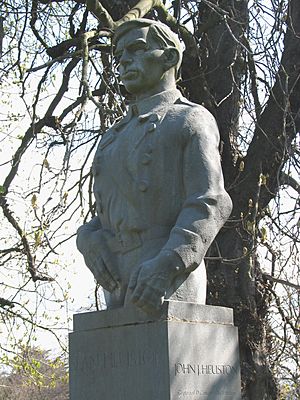Seán Heuston facts for kids
Quick facts for kids
Seán Heuston
|
|
|---|---|
 |
|
| Birth name | John Joseph Heuston |
| Born | 21 February 1891 Dublin, County Dublin, Ireland |
| Died | 8 May 1916 (aged 25) Kilmainham Gaol, Dublin, Ireland |
| Allegiance | Irish Volunteers Fianna Éireann |
| Years of service | 1913–1916 |
| Rank | Captain (Commandant) |
| Battles/wars | Easter Rising |
Seán Heuston (born John Joseph Heuston; 21 February 1891 – 8 May 1916) was a brave young Irish rebel. He was a member of a group called Fianna Éireann. Heuston played an important part in the Easter Rising of 1916, a major event in Irish history.
With only about 20 other volunteers, he defended a building called the Mendicity Institution in Dublin. They held it for over two days, even though they were only supposed to hold it for a few hours. Sadly, Seán Heuston was later executed by firing squad on 8 May 1916, in Kilmainham Gaol.
Contents
Seán Heuston's Early Life
Seán Heuston was born in Dublin on 21 February 1891. His father, John Heuston, was a clerk. Seán went to school with the Christian Brothers.
Later, he worked as a railway clerk in Limerick. While there, he became very active in Fianna Éireann. This was a youth organization that taught young people about Irish history and prepared them for defending Ireland.
Learning and Leading in Limerick
Seán Heuston was an officer in Fianna Éireann. He helped members who couldn't afford uniforms by letting them pay small amounts each week.
Under his guidance, the Fianna in Limerick learned many skills. They practiced drilling, signaling, and scout training. They also learned how to use weapons. On top of that, they had lessons on Irish history and the Irish language.
Joining the Irish Volunteers
In 1913, Seán Heuston moved to Dublin. He joined the Dublin branch of Fianna Éireann, becoming part of the Emmet Sluagh. He also joined the Irish Volunteers, another important group working for Irish independence.
Heuston quickly became a leader. He was the Director of Training for Fianna Éireann. He was also the Vice-commandant of the Dublin Battalion and Commander of the 5th company from August 1915 until the Easter Rising in 1916.
The Easter Rising of 1916
During the Easter Rising, Seán Heuston was in charge of a group of Irish Volunteers. Their mission was to hold the Mendicity Institution in Dublin. This building is now known as Heustons Fort.
Their orders came from James Connolly, another leader of the Rising. Heuston's group was supposed to hold their position for just three or four hours. This was to slow down the British troops and give the main rebel headquarters time to get ready.
Holding the Fort
Seán Heuston and his 26 Volunteers bravely held the Mendicity Institution for much longer than planned. They kept fighting for over two days!
However, their situation became very difficult. British troops were closing in, and the building was almost completely surrounded. Heuston sent a message to Connolly to let him know how bad things were. Two Volunteers, P. J. Stephenson and Seán McLaughlin, risked their lives to deliver the message through sniper fire and British soldiers.
Soon after sending the message, Heuston made the tough decision to surrender.
The Surrender of the Mendicity Garrison
Séamus Brennan, one of the Volunteers with Heuston, described what happened when they decided to surrender. He said their small group of 26 men had been fighting against 300 or 400 British troops all morning.
Machine-gun and rifle fire constantly hit their position. Seán Heuston went to each fighter, encouraging them. But then, the British started throwing grenades into the building. The Volunteers tried to catch the grenades and throw them back before they exploded.
A Difficult Decision
Two of their men, Liam Staines and Dick Balfe, were badly hurt trying to throw back grenades. The Volunteers were almost out of ammunition. They were very tired, had no food, and were completely surrounded. They couldn't fight any longer.
After talking with his men, Seán Heuston decided to surrender. He believed it was the only way to save the wounded and keep everyone else safe. Not everyone agreed, but they followed his order. Before giving up, they destroyed as much of their equipment as they could.
After the Surrender
Séamus Brennan said that the British troops were very angry when they saw how few men had caused them so much trouble. He recalled that the soldiers screamed, cursed, and pushed them around.
An officer asked who was in charge, and Seán Heuston stepped forward without a word. The Volunteers were forced to march to the Royal Barracks (now Collins Barracks) with their hands held behind their heads. At the barracks, British soldiers attacked them, kicking, beating, and spitting on them.
Séamus Brennan never saw Seán Heuston again after they were moved to Arbour Hill Detention Barracks.
Seán Heuston's Court-Martial and Execution
Seán Heuston was taken to Richmond Barracks. On 4 May 1916, he was put on trial by a military court, called a court-martial.
On Sunday, 7 May 1916, Seán Heuston was told the court's decision. He had been sentenced to death and would be shot at dawn the next morning.
His Final Hours

Before his execution, a priest named Father Albert stayed with him. Father Albert later wrote about Seán Heuston's last moments.
He said that Seán was calm. He kissed a small cross before being blindfolded. As they walked to the execution yard, they prayed together. Father Albert described Seán as a "noble soldier of Irish Freedom" who died bravely.
Father Albert felt that the "Heroes of Easter Week" fought bravely and died beautifully and fearlessly. He admired Seán Heuston's courage and strong faith in his final moments.]


